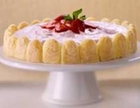|
French Dessert Charlotte Russe A custard-filled cake, made of sponge cake or lady fingers. Invented by the French chef of a Russian czar, the lady behind the title is a guess.
Custard: in a double boiler, cook milk, eggs and sugar together, stirring, until it becomes a thick, creamy custard. Be careful not to boil! Remove from heat and allow to cool slightly. Add gelatin to 1/3 C warm water, once it softens, stir gelatin to dissolve. Add gelatin to custard, mixing thoroughly. Cool. Fold in whipped cream. Assemble: Square off one end of the lady fingers or sponge cake, and line a spring form pan with straight side down.* Pour custard into pan, cover lightly, and chill for at least 5-6 hours or, better, overnight. Unmold on a serving plate and cut into slices when ready to serve. * Traditionally, a charlotte mold is used, a clay-flowerpot-shaped metal pot. |
Tips & Glossary Bouquet Garni: (boo-kay gar-nee) bundle of herbs tied together with string or wrapped in cheese cloth square; usually parsley, thyme, bay leaf, and peppercorns. Flavor is released during long cooking.Remove before serving. Chervil: (sher-vil) related to parsley but has a delicate anise flavor. Long cooking kills flavor, so add at the last minute. Cornichon (kor-nee-shon) teeny-tiny pickle, served with pates & smoked meats; found in specialty food stores. Fines Herbes: (feen-airb) mix of finely chopped herbs: parsley, chives, tarragon, & chervil. Not as strong as a bouqet garni. Buy it at most grocery stores. Fromage: (fra-mahj) Cheese! The French eat more than any nationality, 45 pounds per capita per year; and the country makes more cheeses than any other country, about 400. Herbes de Provence (airb-duh-pro-vonce): mix of dried herbs, usually thyme, rosemary, marjoram, basil, & bay leaf Can be found at most grocery stores. Mutarde: (moo-tard), mustard. Most famous: Nicoise Olive: (nee-swaz- oh-leev) small, purplish-black olive with a mellow, nutty flavor; used primarily in Salade Nicoise. The Picholine variety is a green, medium-sized olive with a light, nutty flavor. Roux: (roo) paste-like mix of melted butter and flour, into which liquid is gradually added. The basis of every classic French sauce.
|
Site by BOOM
![]()
LitLovers © 2024

